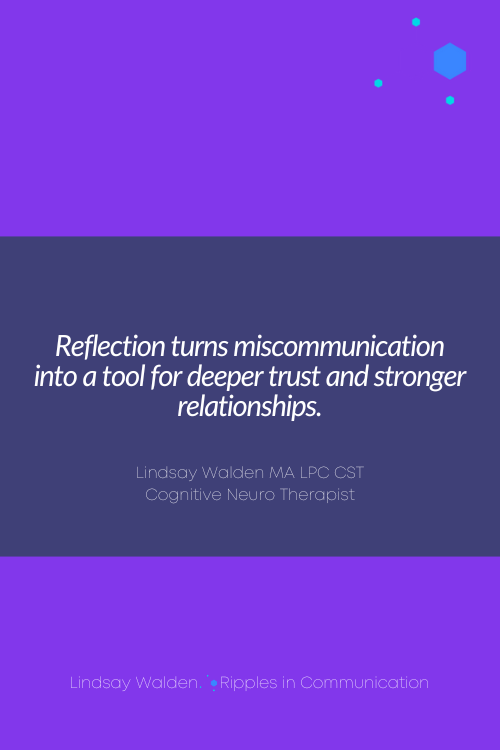How to Turn Miscommunication into Stronger Relationships
Miscommunication happens, even in the best relationships.
A text gets misread. A conversation takes an unexpected turn. Someone assumes the other person knows what they meant—but they don’t.
Suddenly, frustration builds, and what started as a small misunderstanding turns into unnecessary tension.
Sound familiar?
Here’s the truth: Miscommunication isn’t just a problem—it’s an opportunity.
With the right tools, you can turn misunderstandings into moments of growth, connection, and clarity.
That’s exactly why I created the CNT Relationship Reflection Tool, part of the CNT Toolkit Sampler—a simple yet powerful method to help you:
✔ Identify communication patterns that cause frustration
✔ Take accountability for your role in misunderstandings
✔ Develop strategies to improve future interactions
In this post, we’ll explore:
Why reflecting on miscommunication is essential for relationship growth
The neuroscience behind communication breakdowns (and how to fix them)
How to use the CNT Relationship Reflection Tool to improve clarity and connection
Real-life examples of how small shifts can create lasting relationship changes
If you’re ready to stop repeating the same miscommunication patterns and start creating stronger, more aligned relationships, this is for you.
Have you grabbed your FREE CNT Toolkit Sampler yet? It’s packed with science-backed tools designed to help you regulate emotions, manage stress, and develop deep self-awareness. If you’ve ever felt overwhelmed by your reactions or stuck in negative thought patterns, this toolkit will give you the proven strategies I use with clients to help them strengthen emotional neutrality, rewire unhelpful responses, and build lasting resilience. Inside, you’ll find practical exercises and guided reflections to help you navigate challenges with clarity and confidence. Enter your email below, and I’ll send it straight to your inbox!
Why Reflecting on Miscommunication Matters
Most people view miscommunication as a frustrating roadblock. But in reality, it’s a mirror showing us where we can grow.
Instead of thinking:
❌ “They never listen to me.”
❌ “Why do we always miscommunicate?”
Shift the perspective to:
✔ “Where did our communication break down?”
✔ “Where did our communication break down?”
✔“How can I clarify things better next time?”
When you take time to reflect, you gain insight into your own communication patterns, reactions, and assumptions.
Reflection Helps You:
Identify Patterns – Recognize recurring communication breakdowns and what triggers them.
Take Accountability – Understand how your assumptions, tone, or lack of clarity may contribute to misunderstandings.
Improve Future Interactions – Develop strategies to communicate more effectively moving forward.
The Neuroscience Behind It
Reflection activates the prefrontal cortex—the part of the brain responsible for problem-solving, emotional regulation, and thoughtful responses.
When you reflect, your brain moves out of reactive mode (where frustration and defensiveness thrive) and into solution mode (where clarity and connection happen).
The more you practice, the easier it becomes to communicate in a way that prevents misunderstandings before they even start.
How to Use the CNT Relationship Reflection Tool
The CNT Relationship Reflection Tool is a simple yet powerful way to analyze past miscommunications and create better communication habits.
Here’s how to use it:
1. Think of a Recent Miscommunication
Identify a specific situation where communication broke down.
Choose something small but meaningful—maybe a disagreement with a friend, a misunderstanding with your partner, or a moment at work where things got lost in translation.
2. Write About Assumptions You Made
Ask yourself:
What did I assume about the other person’s thoughts, feelings, or understanding?
Did I expect them to know something I never actually said?
Example: "I assumed they understood my perspective without clarifying it."
3. Reflect on How You Could Have Clarified
Ask yourself:
What could I have done differently to ensure clarity?
Did I give them space to ask questions or express their thoughts?
Example: "I could have asked more questions to confirm their understanding."
4. Plan Proactive Actions for Next Time
Instead of dwelling on the past, use this reflection to make future interactions better. Ask yourself:
What’s one small shift I can make to avoid this type of miscommunication again?
Example: "Next time, I’ll summarize what we discussed at the end of the conversation to make sure we’re on the same page."
5. Journal with This Prompt:
"What does clarity in communication look like to me, and how can I cultivate it?"
Writing this down helps you solidify your new communication habits and keeps you accountable.
Real-Life Example: How Reflection Helped Mark Improve His Communication
Mark’s Challenge: Mark and his best friend, Sarah, often clashed over scheduling plans. Plans would change, but Mark assumed Sarah would remember previous conversations without needing reminders.
What He Did: Using the CNT Relationship Reflection Tool, Mark realized he was assuming Sarah had the same mental timeline as him. He never actually confirmed details—he just expected her to remember.
The Outcome: Mark started summarizing agreements at the end of their conversations and following up with quick reminders. The result? Fewer conflicts, more clarity, and a stronger friendship.
Takeaway:
Most miscommunication isn’t intentional—it’s just unspoken expectations.
A little clarity upfront can prevent a lot of frustration later.
3 Tips for Avoiding Miscommunication in the Future
Use “I” Statements – Instead of blaming, focus on your feelings and perspective.
✔ Example: “I felt confused when the plan changed,” instead of “You always change plans without telling me.”
Ask for Clarification – Don’t assume—confirm.
✔ Example: “Just to be clear, are we meeting at 6 or 6:30?”
Be Specific – Avoid vague language that can be misinterpreted.
✔ Example: Instead of “Let’s talk later,” say “Let’s call each other at 7 PM.”
Small adjustments like these create major improvements in communication.
The Benefits of the Relationship Reflection Tool
Improved Emotional Awareness – Helps you understand your own communication habits.
Stronger Relationships – Taking responsibility for miscommunication builds trust and connection.
Enhanced Problem-Solving – Equips you with tools to handle future communication challenges effectively.
When you reflect, you don’t just fix past miscommunications—you prevent future ones.
Strengthen Your Communication with Reflection
Miscommunication doesn’t have to damage your relationships—it can actually deepen them.
The CNT Relationship Reflection Tool gives you a step-by-step system to:
✔ Learn from past miscommunications
✔ Build clarity and trust in conversations
✔ Improve the way you connect with the people who matter most
Download the CNT Toolkit Sampler now and start using the Relationship Reflection Tool to improve your communication today.
Because the best relationships aren’t free of misunderstandings—they’re built by people who know how to work through them with intention.
Final Thoughts
Think of a recent miscommunication you had.
Now ask yourself:
What assumption did I make?
How could I have clarified things better?
What’s one small shift I can make to improve communication next time?
Don't forget to Download the CNT Toolkit Sampler Now and start turning communication challenges into deeper connections today.








